7 Types of Hanfu Skirts: A Guide to the Most Popular Styles

In this post, I’ll quickly go over the most popular types of Hanfu skirts (known as qun or 裙) and explain the differences between them. I won’t go into as much detail as my previous post, but I’ll give you an overview of their names, history, structure, and unique features so you can get a better understanding of the variety of Hanfu skirts out there.
Before we dive into the details, let’s first go over some basic rules for Hanfu skirt styles. Typically, skirts are made from one or two pieces of fabric, either pleated or flat, wrapped around the body and tied with ribbons or cords. While there are exceptions due to modern adaptations of Hanfu, Han elements make these garments easier and more stylish to wear.
The waistband of the skirt is usually 6-8 cm wide and is made from fabric that’s different from the skirt itself. The top part of the skirt that’s attached to the waistband is called the skirt head (裙头). Despite these rules, there’s still a wide variety of traditional Chinese skirts across different dynasties. Let’s get into it!
7 Types of Hanfu Skirts
Pleated Skirts
The classic pleated Hanfu skirt is probably the most well-known Hanfu skirt style. This type of skirt is made from straight knife pleats (called shun zhe 顺折) that run from the waistband all the way down to half or the full length of the skirt. The pleats are usually about 2-4 cm wide and are often made from light chiffon. They might have one or two layers, with a plain white inner layer and a transparent outer layer.
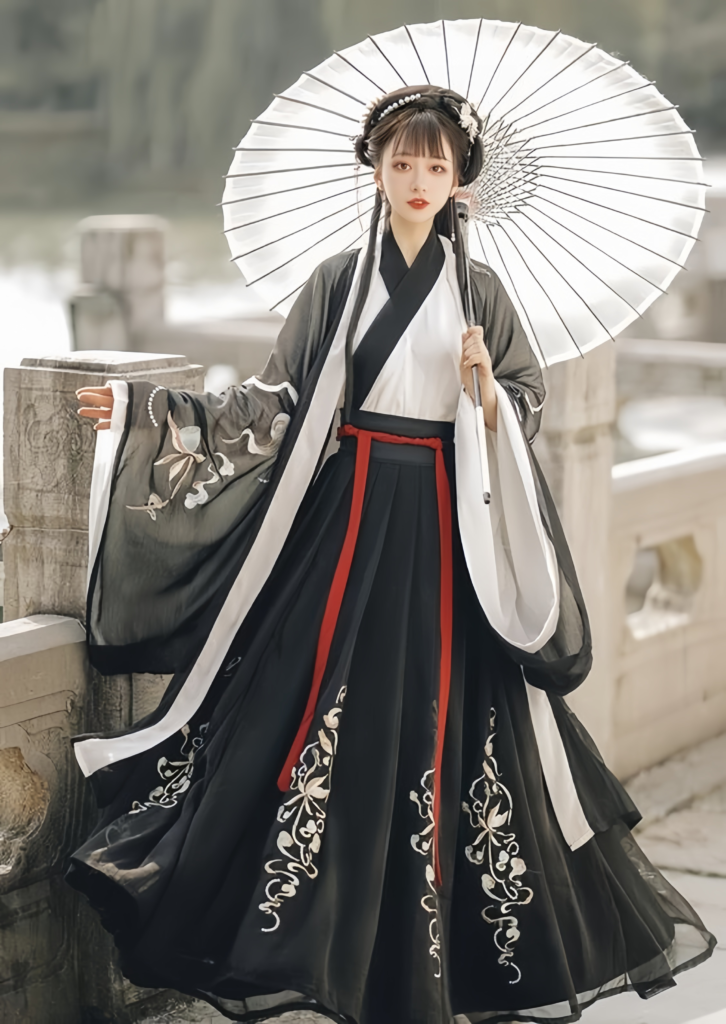
It’s a very basic style, and most people wear this type of traditional Chinese skirts when they’re first starting with Hanfu. It’s unisex, easy to put on, and straightforward. Honestly, there’s not much else to say about it! Its history is a bit unclear because it’s been so popular for such a long time, and it’s a very versatile style. I’m sure many of you are already familiar with this one, so I won’t bore you with more details. Let’s move on!

Poqun (破裙)
Technically speaking, the word po (破) in poqun means “broken.” So why do people wear poqun Hanfu skirts? Well, it doesn’t exactly mean the skirt is “broken.” Instead, poqun refers to long trapezoidal pieces of fabric. A poqun is made up of even-numbered trapezoidal pieces, usually 4 to 12, but it can even go up to 32 pieces! These pieces are stitched vertically together, creating a Hanfu skirts that’s narrow at the top and wide at the bottom. When worn, it forms an A-line shape with loose pleats along the edge. Many Hanfu enthusiasts consider this the most flattering type of traditional Chinese skirts because it helps slim the figure.
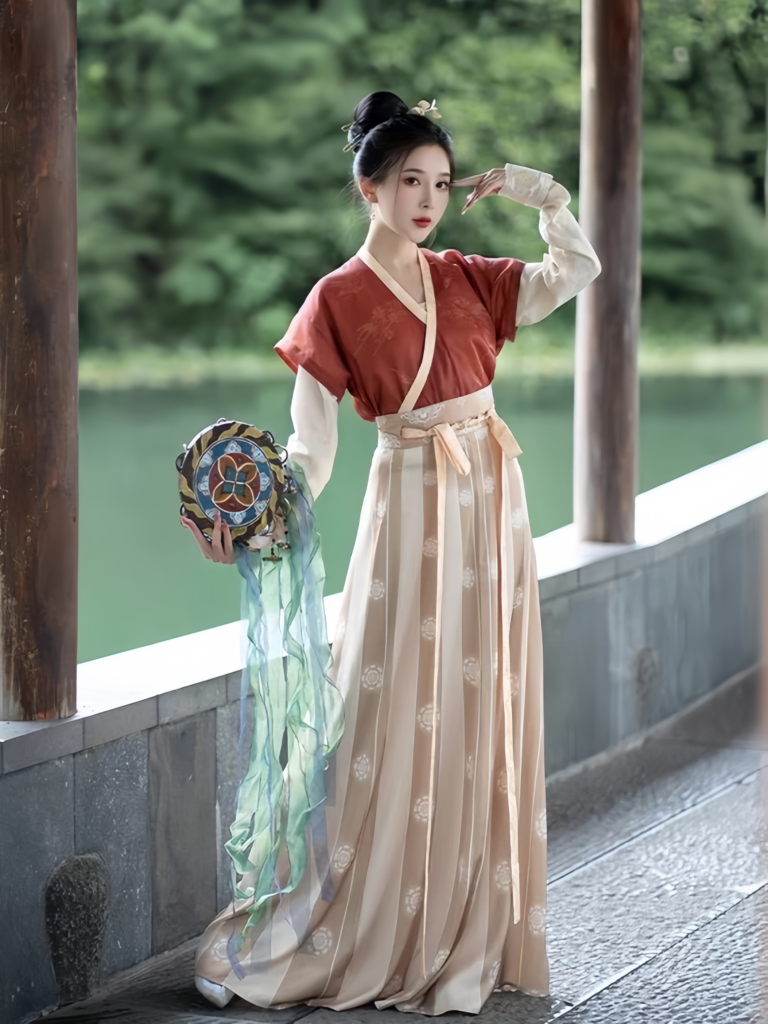
Each of these pieces is called a po, and they come in pairs. For example, a san po (三破) is three po pieces, making it a six-piece skirt. The more pieces, the slimmer the skirt looks! When laid flat, the skirt doesn’t look too impressive, but when you hang it by the waistband, the pieces naturally create a uniform wave effect because of the trapezoidal shape.

This style was most popular from the Wei, Jin, and Tang Dynasties. Early on, skirts replaced robes as the main style, and during the Tang Dynasty, striped bózi tops became fashionable, which made this skirt style even more dominant. However, by the Song Dynasty, other skirt styles started to become more popular, and the flowing, unstructured poqun began to fade.

Sanjian Qun (三襉裙)
So, I mentioned that the poqun Hanfu skirt started to decline during the Song Dynasty, but I didn’t mean it disappeared right away! One evolution of the poqun skirt is the sanjian qun (三襉裙), or “three pleat skirt,” which evolved from the four-piece poqun Hanfu skirt. This skirt typically has four trapezoidal pieces of fabric and is sewn along the edges to create a Hanfu skirts that’s wider at the bottom.

The unique feature of this skirt is that between each pleat, there are three inverted gong zi pleats (工字折), with one in the front center and two on each side. These pleats create a distinct three-pleat slit effect. Sometimes, the inside of these slits is made with contrasting fabric to add more texture and depth.

The sanjian qun became popular among Hanfu lovers who enjoy Han elements because it looks somewhat modern but with a more subtle silhouette. It’s not as voluminous as other skirts, and it hangs more vertically, making it easier to modernize. A word of warning: this type of skirt is known for exposing a little bit of the stomach, which was common in Song Dynasty fashion. But if you don’t mind showing a bit of skin, it’s a great everyday option!
Xuan Qun (旋裙)
If people in the Tang Dynasty admired fuller figures, then people in the Song Dynasty were known for preferring a more slender, elongated body shape. This preference is definitely reflected in their fashion choices, especially when it comes to Hanfu skirts.
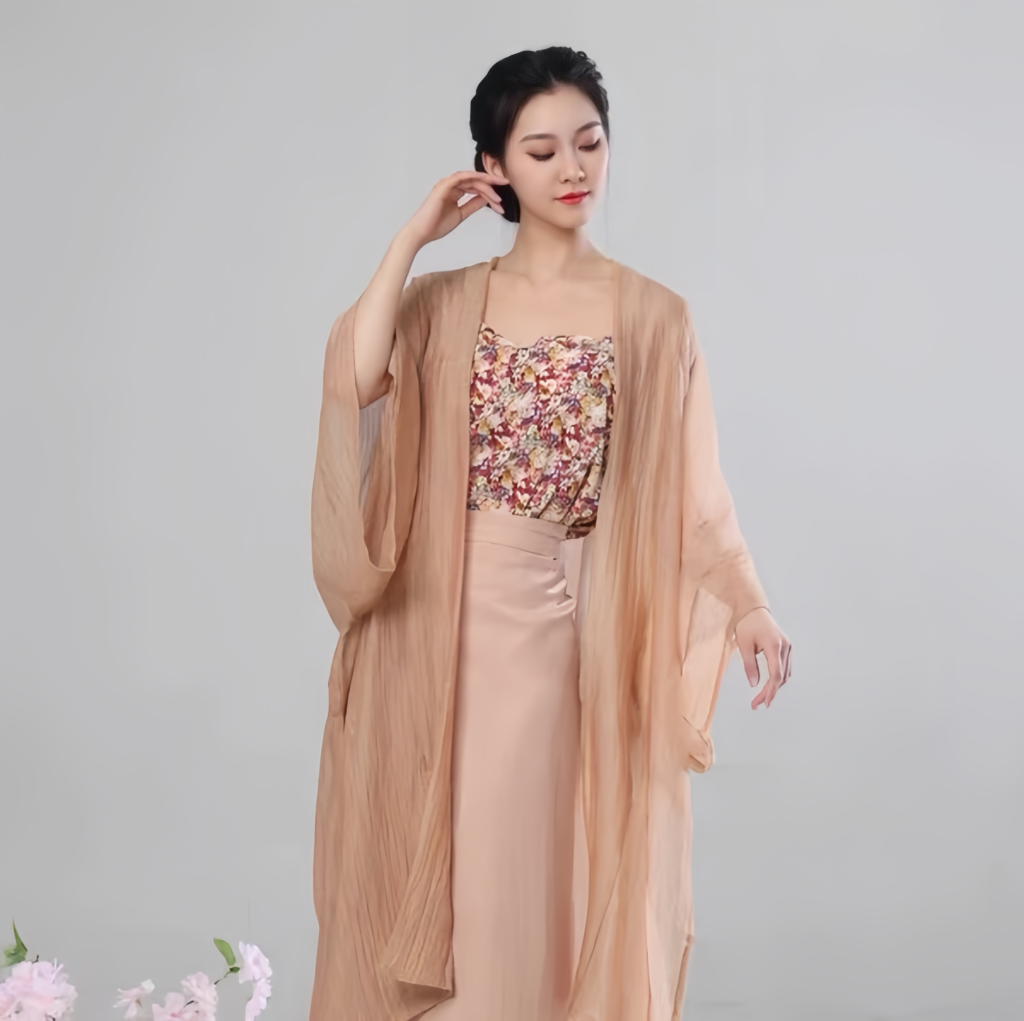
One of the simplest types of Hanfu skirts from this period is the xuan qun (旋裙), also known as the “wrapped skirt” or “two-piece skirt.” It’s made from two pieces of fabric that overlap, and unlike other Hanfu skirt styles, it doesn’t have pleats. Instead, it’s made from two flat rectangular pieces of fabric that are sewn together at the waistband. These two pieces may either match in color or have contrasting patterns.

There are two types of xuan qun: narrow and wide. The narrow version uses less fabric, which means it wraps tighter around the waist, hips, and legs, creating a more form-fitting silhouette, similar to a pencil skirt or straight skirt. The wide version has more fabric and hangs a bit looser, allowing for more freedom of movement in the legs. The narrow version is best for those with slimmer figures, as the fabric clings more tightly to the hips. But if you pick the right size, it should be fine!

Mǎmiàn Qún (马面裙)
The mǎmiàn qun (马面裙), or “horse-face skirt,” is another unique style of Hanfu skirts. This skirt is made from two pieces of fabric that each have a smooth, flat section at both ends, while the middle is pleated. The two sections at the ends create visible flat parts in the front and back of the skirt, with pleats in between. It’s perfect for activities that require leg movement, like horseback riding, and was popular from the Song to the Ming Dynasty. This style of Hanfu skirt has a distinctive silhouette, making it an essential part of traditional Chinese skirts.
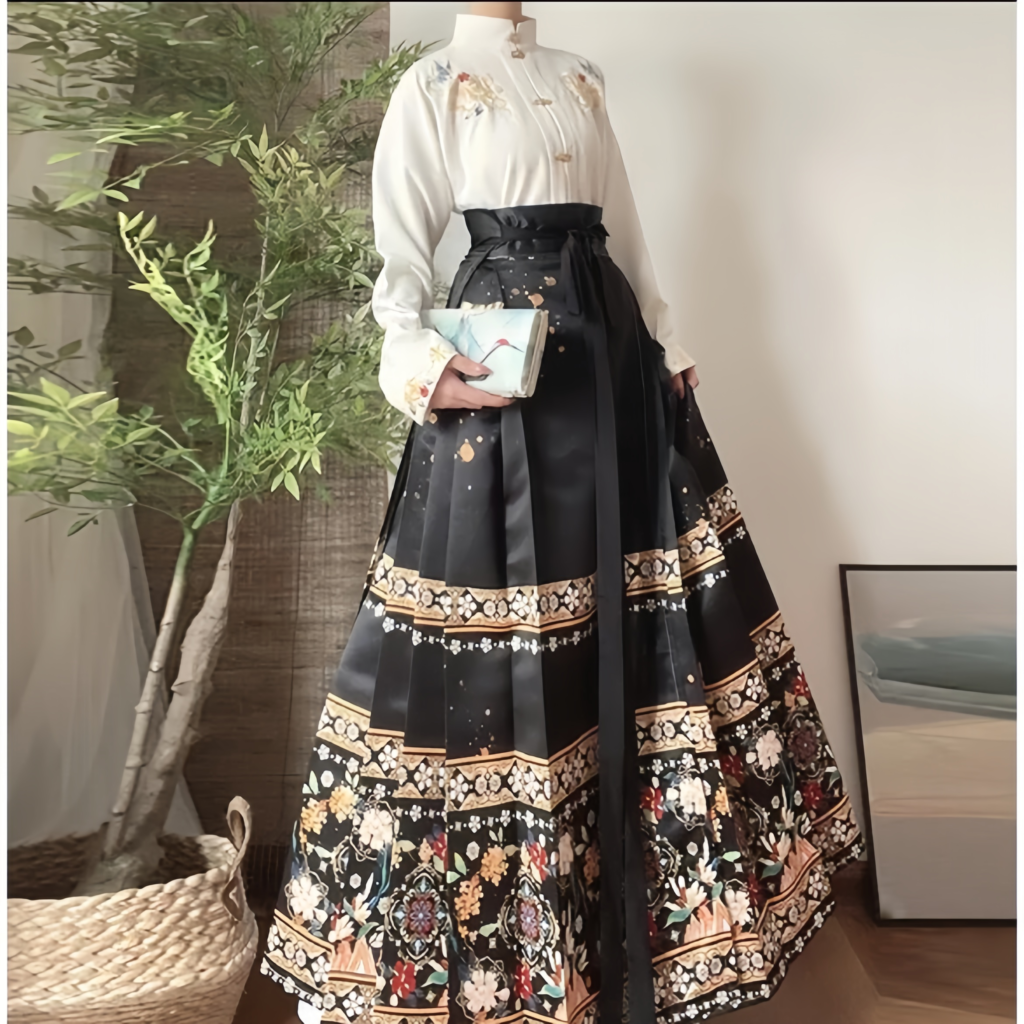
Mànzhě Qún (满褶裙)
A lesser-known relative of the mǎmiàn qun is the mànzhě qun (满褶裙), also known as the “full-pleated skirt” or “all-pleat skirt.” While it’s less common than the mǎmiàn qun, this style was popular during the Ming Dynasty and is still recognized in some collections today.

It’s made of two pieces of fabric, both featuring knife pleats in the same direction. When stitched together, it creates a skirt that’s entirely pleated, giving it a fuller look than the mǎmiàn qun because it lacks the flat sections at the edges. However, it’s less practical for leg movement because the pleats tend to shift when you sit down, making it harder to keep tidy. Still, if you’re looking for a more traditional Ming-style outfit, this is a great option.
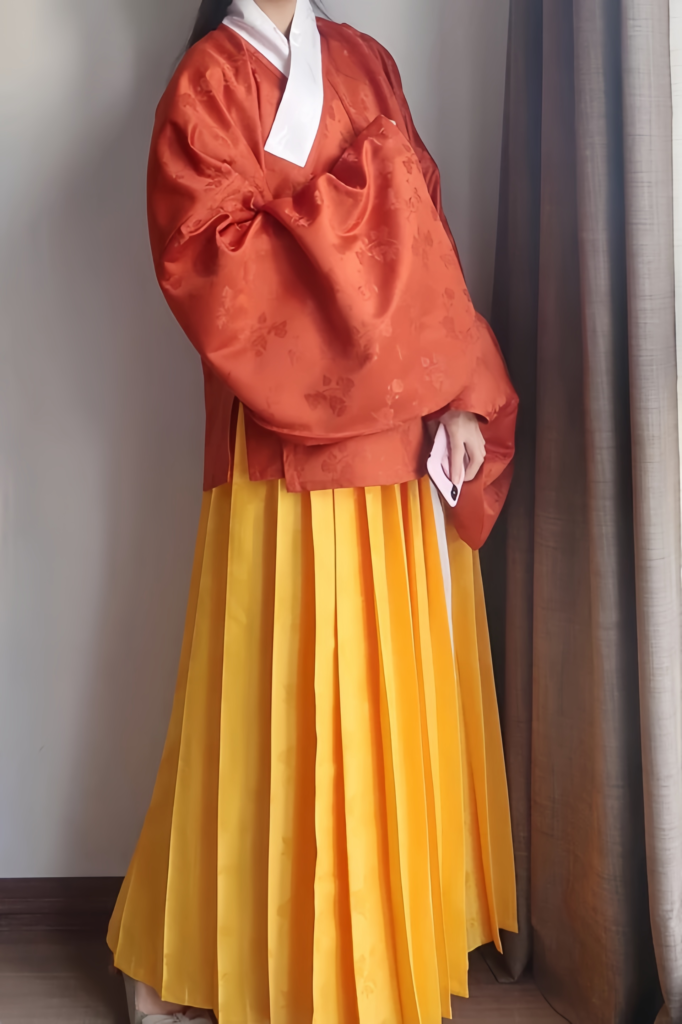

Bǎidié Qún (百蝶裙)
Finally, the bǎidié qun (百蝶裙), or “hundred-pleat skirt,” is a very narrow pleated skirt, usually about 1-2 cm wide. It’s made from soft, lightweight fabric and has a smooth, flat section at both ends, similar to the mǎmiàn qun. However, the pleats on this skirt are thinner, and the smooth part overlaps at the front, back, or side—depending on how you want to wear it.


There are three types of bǎidié qun: the full pleat version, the surrounding pleat version, and the high-low pleat version. The full pleat skirt is the most common, while the surrounding pleat version is typically worn as an outer skirt or over another piece of clothing. The high-low pleat skirt is a rare style, where the smooth part is cut shorter than the pleats, creating a T-shape effect when laid flat.


Qi Xiong, Qi Yao, and He Zi Qun (齐胸、齐腰、和子裙)
Now, you might be wondering about the qi xiong (齐胸) and qi yao (齐腰) skirts. These aren’t actually different types of skirts, but just different ways of wearing them! The only real difference is that a qi xiong skirt is worn higher, closer to the chest, while a qi yao skirt sits at the waist.
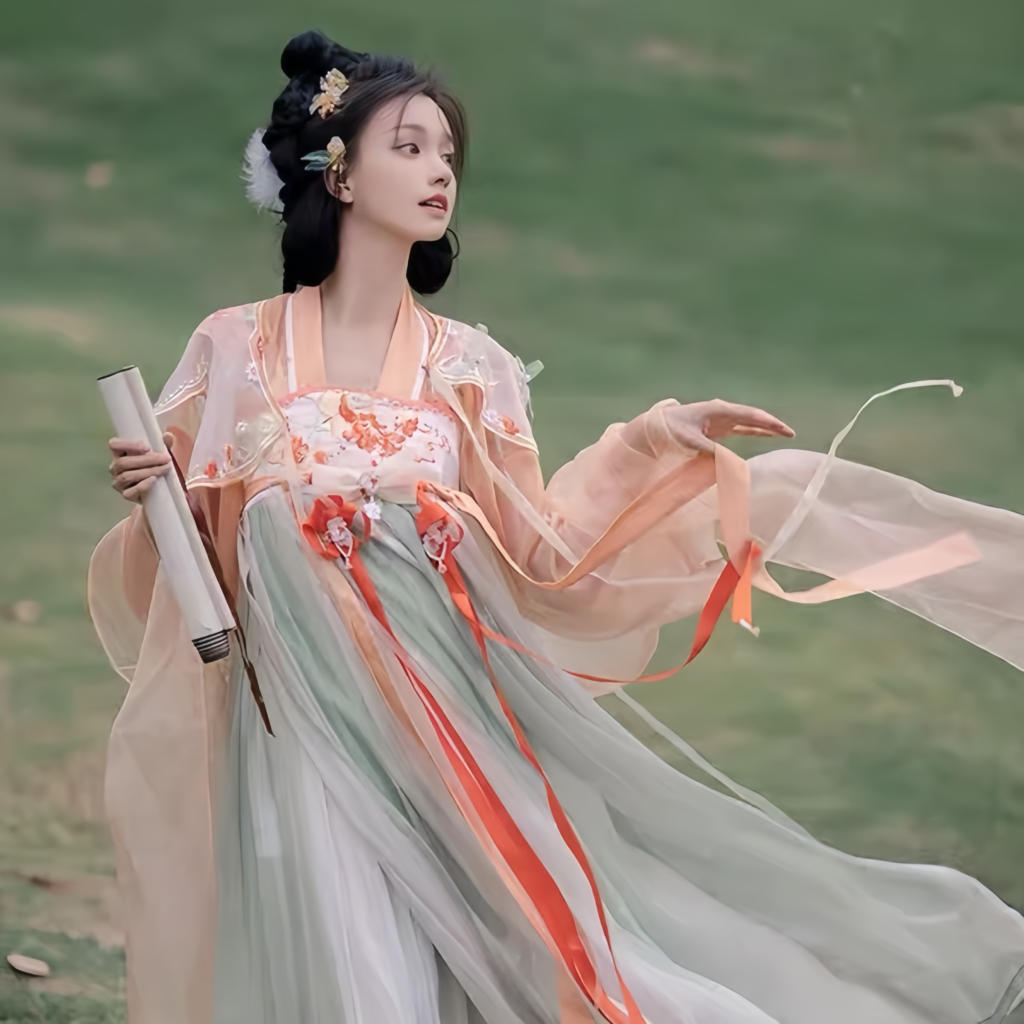
Designers might make adjustments for either look, but conceptually, there’s no difference. You can always wear a skirt higher or lower, depending on your preference. So, whether it’s a

qi xiong or qi yao, it’s really just a matter of how you choose to wear it.

I hope this gives you a good overview of the different types of Hanfu skirts! From the classic pleated styles to the elegant mǎmiàn qun (horse-face skirt), each type offers a unique look and reflects the rich history behind traditional Chinese skirts. There’s so much history and variety in these styles, and each one tells a unique story about the times it came from.
Whether you’re drawn to the simple elegance of the pleated Hanfu skirt or the more intricate designs like the poqun, every Hanfu skirt style has its own charm and purpose. Exploring these different Hanfu skirt styles is a great way to understand the cultural significance of traditional Chinese fashion and how it has evolved over the centuries.
To learn more about the culture of Hanfu, visit ChinaCulture.org.

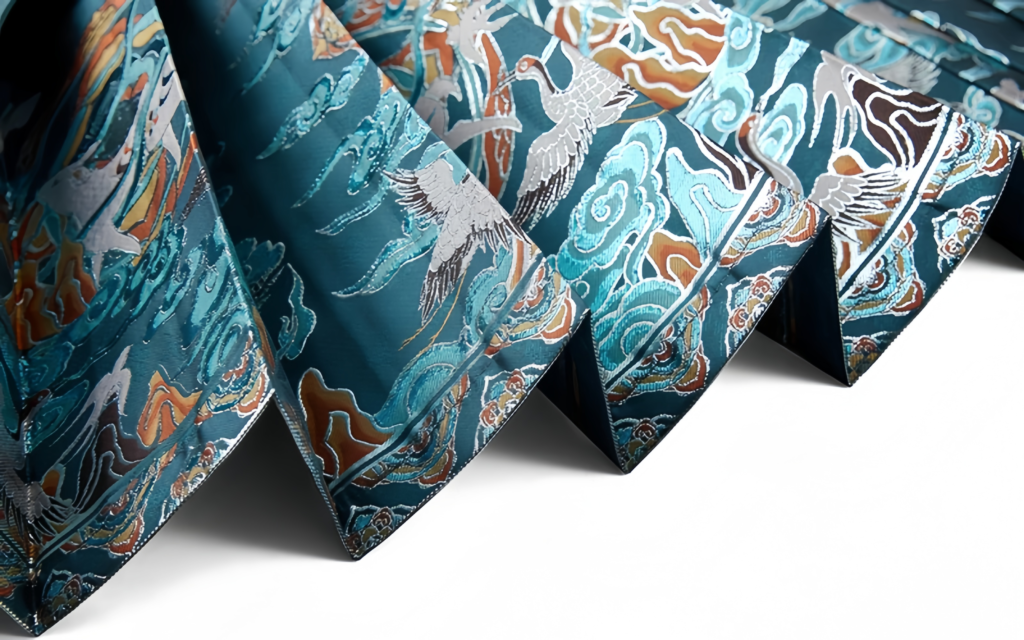



Responses